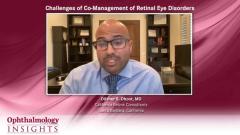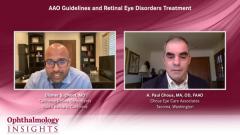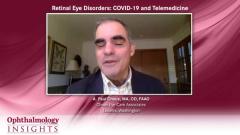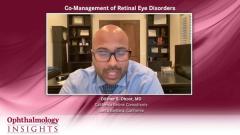
AAO Guidelines and Retinal Eye Disorder Treatment
Dilsher S. Dhoot, MD, and A. Paul Chous, MA, OD, FAAO, discuss the American Academy of Ophthalmology (AAO) guidelines on co-management between optometrists and ophthalmologists in retinal eye disorders.
Episodes in this series

A. Paul Chous, MA, OD, FAAO: We’ll move on to another topic. We were asked to consider the American Academy of Ophthalmology’s guidelines for comanagement of patients. I wonder about your thoughts. To what extent does that apply to the relationship between nonsurgical providers, ie optometrists and retina specialists? Does it apply? Are we doing a good job collaborating with one another?
Dilsher S. Dhoot, MD: These guidelines, when it comes to retina, are not typically considered because most of the guidelines address surgical comanagement and surgical conditions. The No. 1 surgical comanagement condition is cataract, right? Most retina folks aren’t doing cataract surgery, but the comanagement of vitrectomy is generally less prevalent. We don’t do comanagement per se in terms of surgical management of patients, but we certainly have comanagement and collaboration when it comes to medical retina. We’re often seeing patients and sharing those patients with optometrists, so the pre- and post-operarative guidelines don’t strictly apply to those.
The tenets of the guidelines are that things should be done in an ethical fashion. If you have a relationship with an optometrist when it comes to surgical comanagement—that there should be some necessity—then it should be transparent to the patient that this relationship is there, and the patient should be on board with this. You should be comanaging with a provider you feel can adequately substitute for you in the perioperative period as the retina specialist and is able to pick up on the key things that need to be evaluated.
Aside from that, there’s a much larger collaboration with comanagement when it comes to medical retina. I’m sure you have a similar relationship with retina specialists in Tacoma, Washington. We comanage patients. For example, in diabetes, we may initially manage patients and see a patient in which there may be some concern regarding moderate or severe NPDR . The patient may see optometry more frequently, and a provider who will refer that patient as soon as they see a worsening of DR status. Fifty percent of patients with severe NPDR can convert to proliferative diabetic retinopathy within a year, but they may be seeing their optometrists during that time before they see a retina specialist or even between RS visits. We rely on optometrists to be our eyes and ears when we’re not seeing these patients. You optometrists continue to manage other conditions, such as glaucoma, or dry eye, or changes in refractijon - conditions that we’re not treating necessarily. Most of us don’t even have visual fields, so there are conditions like that. What do you think, Paul?
A. Paul Chous, MA, OD, FAAO: That’s a great point. As I tell my colleagues in optometry, you have a lot of patients getting anti-VEGF injections. One of the potentialities there is increased intraocular pressure. That’s something you should be monitoring, letting the retina specialists know if the IOP [intraocular pressure] is going up and proposing or initiating a treatment, especially if it remains chronically elevated. Dry eye and refractive shifts are also very common in these patients.There are lots of areas where we can work together in such a way that patients receive comprehensive care.
Dilsher S. Dhoot, MD: I like that you make a follow-up appointment with your patients because I recommend that. Let’s say you’re referred to Dr Dhoot for wet AMD [age-related macular degeneration]. That patient may be someone I treat for the rest of their lives. They may be getting injections on average every 9 or 10 weeks. I’ll be seeing them, and I’ll send correspondence back to my optometry colleagues. But unless the patient prompts me or reminds me that they need something other than injections, which is my universe, I may forget to send them back. I never want someone to feel like we didn’t send the patient back because we always try to send them back to the referring doctor for refractions or if they have other issues—for example, if they need cataract surgery. We’ll send them back to our optometry colleagues to work with whom they like best.
A. Paul Chous, MA, OD, FAAO: Retina specialists have done a really good job with that. The key thing that would be useful to your optometric partners would be to let us know when you think the patient has achieved some level of stability, purely from a refractive standpoint. We see patients all the time who say, “I had an injection. I’m seeing better.” Maybe they went from 20/200 to 20/60 with anti-VEGF. “Is it time? Can I get new glasses now?” The answer, of course, is yes. You’re having difficulty functioning in the real world, and I can make you see better, but I want the OD [optometrist] to tell the patient, “You may not have good stability yet. What did Dr Dhoot tell you about the ongoing frequency of treatment that he’s going to deliver? Does he think you’ve leveled off with your retinal status? We don’t want you to spend moneyon a pair of glasses that aren’t going to work for you for very long, right?”
Dilsher S. Dhoot, MD: Yes, 100%. Usually, I’ll try to send a letter or say something like, “OK for MRX [manifest refraction] vs ‘ Cat Eval’” That’s my code. If I put ‘ Cat Eval,’ then maybe the cataract is coming of age. But you’re exactly right. Optometry sets these follow-up appointments because it can get lost in the shuffle. Patients sometimes have many other appointments, especially those with diabetes. I saw a statistic that they have, on average, 24 physician appointments a year. It’s pretty insane. It’s nice that you guys get in the queue.
A. Paul Chous, MA, OD, FAAO: I’d like to throw that to every health care provider. In 2012, the NHANES [National Health and Nutrition Examination Survey] analysis said that 52% of all US adults have prediabetes or diabetes. It’s the new default. A majority of the population has blood glucose dysmetabolism. A recent analysis in western Europe says that about 13% of people with identified prediabetes already have lesions consistent with diabetic retinopathy [DR], which raises the important question, do they really have diabetes? It just hasn’t been identified.
It’s useful for ophthalmology and optometry to be better versed in the diagnostic criteria for diabetes out there. A lot of patients have diabetes. They’ve got end-organ manifestation of the disease, but it hasn’t been diagnosed as such. Don’t rely only on a fasting blood glucose test. I have multiple examples of patients with DR, even diabetic kidney disease, with hemoglobin A1C (glycated hemoglobin) in the prediabetes range. Their fasting glucose is OK, but if you do a glucose challenge, a glucose tolerance test, their blood glucose levels are way above the threshold for diagnosing diabetes. We know we’re diagnosing the disease late, about 6½ years after the onset of diabetes based on the prevalence of retinopathy at the diagnosis of type 2 diabetes. Those of us in eye care can help our primary care provider colleagues do a better job of getting patients diagnosed sooner so we can prevent complications. That’s my spiel about diabetes.
Dilsher S. Dhoot, MD: I like it. Those are all great points. You’re exactly right. There’s going to be a gray area that’s considered not diabetic or prediabetic vs full-on diabetic, but that gray area is very gray. Catching it is going to benefit the patient.
TRANSCRIPT EDITED FOR CLARITY
Newsletter
Don’t miss out—get Ophthalmology Times updates on the latest clinical advancements and expert interviews, straight to your inbox.

























































